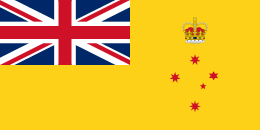Henry Winneke
| Sir Henry Winneke AC, KCMG, KCVO, OBE, QC | |
|---|---|
|
| |
| 21st Governor of Victoria | |
|
In office 1 June 1974 – 28 February 1982 | |
| Monarch | Elizabeth II |
| Preceded by | Sir Rohan Delacombe |
| Succeeded by | Sir Brian Murray |
| Personal details | |
| Born |
Henry Arthur Winneke 20 October 1908 Fitzroy North, Victoria |
| Died |
28 December 1985 (aged 77) Shoreham, Victoria |
| Spouse(s) |
Nancy Wilkinson (1933–83; her death) Ellis Faul (1984–85; his death) |
| Children | John Winneke |
| Education | University of Melbourne |
| Profession | Barrister; judge |
| Military service | |
| Allegiance | Australia |
| Service/branch | Royal Australian Air Force |
| Years of service | 1939–46 |
| Rank | Group Captain |
| Battles/wars | Second World War |
| Awards | Officer of the Order of the British Empire |
Sir Henry Arthur Winneke AC, KCMG, KCVO, OBE, QC (20 October 1908 – 28 December 1985) was a Chief Justice of the Supreme Court of Victoria and the 21st Governor of Victoria from 1974 to 1982.
Early life and career
Winneke was born in 1908 to the descendants of German immigrants to Victoria. His father, Henry Christian Winneke was a judge of the County Courts of Victoria. Winneke was educated at Ballarat Grammar School, Scotch College and the University of Melbourne, from which he graduated LLB in 1929 and LLM in 1930. He was a hockey player while at University, and was awarded a University Blue as well as playing in an Australian Universities team. After doing articles at the solicitors firm Gair & Brahe, he was admitted to practice in the Supreme Court of Victoria on 1 May 1931 and called to the Victorian Bar on 30 July 1931. He read as a pupil of Wilfred Fullagar, who was later a judge of the High Court of Australia.
Second World War
Following the outbreak of the Second World War, he was commissioned in the Royal Australian Air Force (RAAF) in October 1939. He was subsequently promoted to wing commander on 1 October 1941 and to group captain a month later, when he was appointed Director of Personnel Services. He was appointed an Officer of the Order of the British Empire in 1944.
Post-war career
Following the end of the Second World War, Winneke left the RAAF returned to practice at the Victorian Bar. He developed a large general practice, and was described by Sir John Young (his successor as Chief Justice) as "a very sound lawyer with a clear and penetrating mind", and a "clear and powerful advocate" ([1986] VR p xi). He was appointed a Kings Counsel in 1949. Winneke became Solicitor-General for the State of Victoria in 1951. In that capacity, he regularly prosecuted in important Criminal trials, and also appeared for the State of Victoria in Constitutional cases in the High Court of Australia and the Privy Council. While Solicitor General, he provided robust advice to the Victorian Government and refused to be swayed by political considerations. This included advising the then Victorian Premier Sir Henry Bolte and Chief Secretary Sir Arthur Rylah that they might be guilty of intentional unlawful homicide, or murder, if the Government hanged a convicted murderer named Robert Peter Tait notwithstanding a temporary stay on his execution granted by the High Court of Australia (see Tait v R (1962) 108 CLR 620).
Chief Justice and Governor
Winneke was appointed as Chief Justice of the Supreme Court of Victoria in 1964. According to Sir John Young, he was "a model of fairness", who delivered judgments which "were models of clarity and learning" ([1986] VR p xii). He was appointed Lieutenant Governor of Victoria in 1972. In 1974, he retired from office as Chief Justice and became the Governor of Victoria, an office which he occupied with "great distinction" until 1982. He was knighted in 1957, created KCMG in 1966, KCVO in 1977 and AC in 1982. He received the honorary degree of Doctor of Laws from the University of Melbourne in 1978 and Monash University in 1980.
Don Chipp said that Winneke had told him in 1971 that the convicted murderer Leith Ratten was innocent. In 1981, when Ratten had yet to be released, Chipp said Winneke denied the conversation had taken place. Later a member of the Supreme Court at the time of Ratten's trial told Tom Molomby that Winneke had wanted to remove the jury from the trial. Such a move would require a belief that the evidence would not support a guilty verdict.[1]
Personal life
He was married twice, first to Nancy Wilkinson in 1933 by whom he had two sons, John and Michael. Following his first wife's death in 1983, in 1984 he married Ellis Faul, who survived him. His son, John Winneke, was also a judge on the Supreme Court of Victoria, being President of the Court of Appeal from its inception in 1995 until his retirement in 2005. Winneke was a keen golfer and follower of Australian Rules Football, being at one time the number one ticket holder of Hawthorn Football Club.
See also
References
- ↑ Molomby, Tom, Is there a moderate on the roof? ABC Years, William Heinemann Australia, Port Melbourne, 1991, pp.84–85
Further reading
- Obituary, [1986] Victorian Reports, pp xi–xii.
- Coleman, Robert, Above renown: The biography of Sir Henry Winneke, South Melbourne, MacMillan Australia, 1988.
| Legal offices | ||
|---|---|---|
| Preceded by Sir Edmund Herring |
Chief Justice of the Supreme Court of Victoria 1964–1974 |
Succeeded by Sir John Young |
| Government offices | ||
| Preceded by Sir Edmund Herring |
Lieutenant Governor of Victoria 1972–1974 |
Succeeded by Sir John Young |
| Preceded by Sir Rohan Delacombe |
Governor of Victoria 1974–1982 |
Succeeded by Sir Brian Murray |

